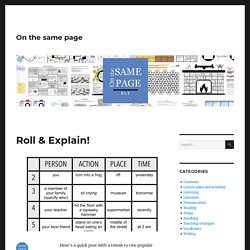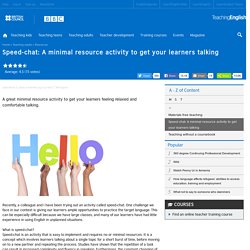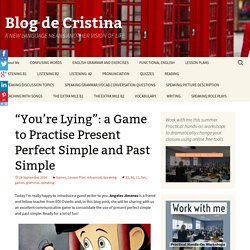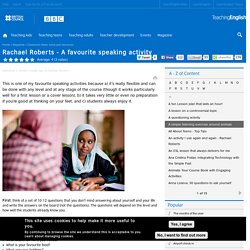

Persuading someone to do something. Ana: Hi!

I'm Ana. Welcome to What to Say! Do you know what to say when you want to persuade someone to do something? Listen out for useful language for persuading someone to do something. Then, we'll practise saying the new phrases – after this. Paul: OK. Noelia: Hey, Paul, have you got a minute? Paul: Go on, then. Roll & Explain! Here’s a quick post with a tweak to two popular speaking/writing activities.

The game can be played in small groups or as a whole class (B1 and above.) Roll&Explain.pdf One student rolls two dice four times: one to choose the person in the situation, another one for the action, a third one to decide on the place, and finally a fourth one to determine the time. Focus on grammar first by having the student come up with a grammatically correct sentence that describes the situation.
The variety of time references, for example, will demand different tenses and aspects (and situations can change drastically due to this!) Once the situation is clear, the student comes up with a (more or less) plausible explanation for it. Like this: Like Loading... 7 Fun Tasks for Classroom Debates. Speed-chat: A minimal resource activity to get your learners talking. Recently, a colleague and I have been trying out an activity called speed-chat.

One challenge we face in our context is giving our learners ample opportunities to practice the target language. This can be especially difficult because we have large classes, and many of our learners have had little experience in using English in unplanned situations. What is speed-chat? Speed-chat is an activity that is easy to implement and requires no or minimal resources. It is a concept which involves learners talking about a single topic for a short burst of time, before moving on to a new partner and repeating the process. Teachers, organize your learners so that they are sitting in pairs and facing each other, in rows or a circle.
Then, start a stopwatch and the learners should aim to talk for the duration of the set time, which will depend on their level, their confidence in speaking in unplanned situations, and the chosen topic. What have we seen after implementing ‘speed-chat’? Describing photos (comparing, contrasting and speculating)
You are going to practise language for; Describing photosComparing and contrasting photos (discussing similarities and differences)Speculating on what might be happeningReacting to photos (giving opinions) Discuss Look at the presentation.

Follow the instructions and talk about some of the photos Write The language used here for comparing and contrasting / speculating is also useful for writing discussion / argument essays. Plan: Introduction - describe the situation / topic to be discussedCompare / contrast ideas (for and against / advantages and disadvantages)Speculate on solutions to problems raised by the questionConclusion - give an opinion Which pairs or groups of photos in the presentation could be used to demonstrate ideas for argument writing topics about education, technology, food, family, work, leisure, health, advertising etc? More Practice on May / Might / Could / Must / Can't. A game to improve your spoken English - just a minute. Speaking activities. “You’re Lying”: a Game to Practise Present Perfect Simple and Past Simple.
Today I’m really happy to introduce a guest writer to you.

Angeles Jimenez is a friend and fellow teacher from EOI Oviedo and, in this blog post, she will be sharing with us an excellent communicative game to consolidate the use of present perfect simple and past simple. Ready for a lot of fun! Do you want your students to keep their noses in the course book? Don’t read on then. Rachael Roberts - A favourite speaking activity. First, think of a set of 10-12 questions that you don’t mind answering about yourself and your life and write the answers on the board (not the questions).

The questions will depend on the level and how well the students already know you. For example, some lower level questions might be: Where do you live? Speak Up: 6 Fabulous Games to Get Your Students Speaking. Warmers and fillers for the online classroom - EnglishUp. The online classroom can at times seem like a very cold space and building a supportive and friendly environment for students while getting a clear idea of their capabilities can be quite challenging.

Having some zero preparation activities up your sleeve to get students speaking can be a real benefit. Here are some of my favourite warmers and fillers to get students speaking. Find out about Aptis for Teachers Alphabet vocabulary This is a simple warmer that can work with any level from elementary upwards and can help to get students thinking in English and revising their vocabulary. Suggest a subject that your students have studied such as food, sport, objects around the house, etc. Example: Topic: Fruit and vegetables Apple, banana, courgette, etc. If one of you gets stuck on a letter, the other person wins. You can follow this up by getting the students to write down all the items that they remember from the word chain.